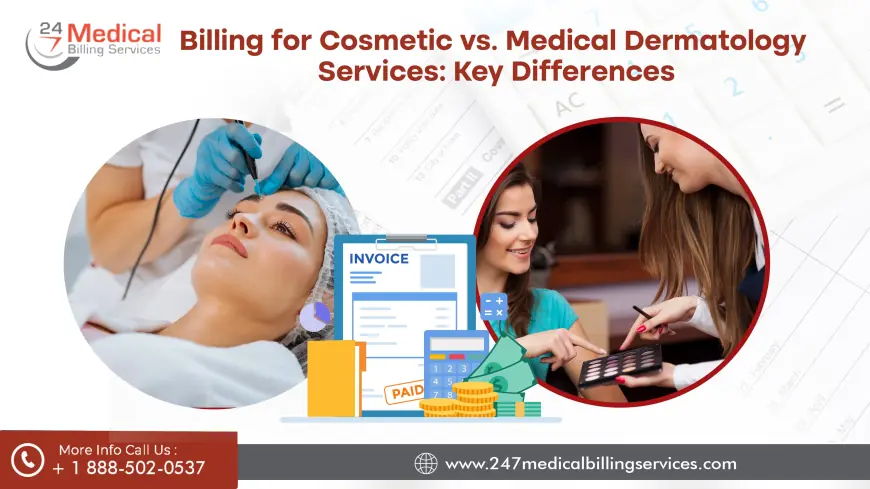Billing for Cosmetic vs. Medical Dermatology Services Key Differences
In the field of dermatology, distinguishing between cosmetic and medical services is essential, particularly when it comes to billing and insurance processes.

In the field of dermatology, distinguishing between cosmetic and medical services is essential, particularly when it comes to billing and insurance processes. Medical dermatology focuses on diagnosing and treating skin conditions that affect a patient’s health, while cosmetic dermatology aims to enhance appearance. Therefore, understanding these distinctions ensures accurate billing, compliance with insurance policies, and appropriate patient care.
Cosmetic Services
Cosmetic dermatology encompasses procedures designed to improve the aesthetic appearance of the skin, hair, and nails. These treatments are elective and primarily focus on enhancing features or reversing signs of aging. Common cosmetic procedures include:
- Injectables: Substances like Botox are used to reduce wrinkles and fine lines by temporarily paralyzing underlying muscles.
- Laser Treatments: Techniques such as laser hair removal and laser skin resurfacing address issues like unwanted hair, sun damage, and acne scars.
- Chemical Peels: Application of chemical solutions to exfoliate and improve skin texture, targeting concerns like pigmentation and uneven tone.
- Dermal Fillers: Injections that add volume to areas like cheeks and lips, diminishing the appearance of wrinkles.
Since these procedures are not medically necessary, they are typically not covered by health insurance. Patients are usually responsible for the full cost, and billing is handled directly between the patient and the provider. This direct payment model simplifies the billing process but requires clear communication about costs and payment expectations.
Medical Dermatology Services
Medical dermatology deals with conditions that impact a patient’s health and require clinical intervention. These services are considered medically necessary and often covered by health insurance. Common medical dermatology services include:
- Skin Cancer Treatment: Procedures like biopsies and excisions to diagnose and remove cancerous lesions.
- Chronic Skin Conditions: Management of diseases such as eczema, psoriasis, and rosacea through medications and therapies.
- Infectious Skin Diseases: Treatment of bacterial, viral, or fungal infections affecting the skin.
- Allergic Reactions: Diagnosis and management of dermatitis and other allergic skin responses.
Billing for medical dermatology involves submitting claims to insurance companies using standardized coding systems like CPT (Current Procedural Terminology) and ICD-10 (International Classification of Diseases). Accurate coding and thorough documentation are crucial to justify the medical necessity of treatments and secure appropriate reimbursement.
Billing for Cosmetic vs. Medical Dermatology Services
The billing processes for cosmetic and medical dermatology differ significantly due to the nature of the services and insurance coverage policies. These are as follows:
- Focus of Treatments
The primary purpose of treatments determines whether they fall under cosmetic or medical dermatology. Medical dermatology involves procedures necessary for diagnosing or treating skin conditions affecting health, such as eczema, psoriasis, or skin cancer. These treatments require proper documentation and coding to reflect their medical necessity using CPT (Current Procedural Terminology) and ICD-10 (International Classification of Diseases) codes. For instance, a skin biopsy may be coded as CPT 11102 for tangential biopsy with an appropriate ICD-10 code such as L40.0 for psoriasis.
In contrast, cosmetic dermatology, focused on aesthetic improvements, typically does not involve insurance claims. These services, like Botox injections or chemical peels, may use internal codes for record-keeping but are not translated into reimbursable claims.
- Medical Necessity
The concept of medical necessity is foundational to coding for medical dermatology services. Insurance providers require coders to prove the necessity of a procedure through accurate ICD-10 diagnosis codes paired with relevant CPT codes. For example, mole removal due to suspected malignancy might use CPT 11400 for excision of benign lesions with an associated ICD-10 code such as D22.5 for dysplastic nevi. Without this justification, claims may be denied.
On the other hand, procedures performed purely for aesthetic reasons, such as mole removal for cosmetic improvement, are classified under cosmetic dermatology. These services are elective and billed directly to patients without insurance involvement, minimizing the need for medical necessity documentation.
- Insurance Coverage
Insurance coverage is directly tied to how procedures are coded. Medical dermatology services are typically reimbursable by insurance if they meet the criteria for medical necessity. Coders must assign precise CPT and ICD-10 codes, supported by detailed patient records, to avoid claim rejections. For example, phototherapy for psoriasis may involve CPT 96910 and ICD-10 code L40.0.
Cosmetic dermatology, by contrast, is not covered by insurance, as it is elective and not medically necessary. While coding may not influence reimbursement, practices should still use internal codes for tracking services and patient records. For example, laser hair removal might be documented with a non-reimbursable CPT code, such as CPT 17999, a generic code for unlisted procedures.
- Billing Process
The billing process for medical dermatology requires thorough documentation to support claims submitted to insurance providers. Coders must ensure that CPT and ICD-10 codes align, proving the medical necessity of the treatment. For example, treating skin cancer may involve CPT 11600 for excision and ICD-10 code C43.9 for malignant melanoma. Errors in coding or documentation can lead to denied claims, delayed payments, or audits.
However, billing is simpler for cosmetic dermatology, as it typically involves direct payment from patients. While coders may still document services for internal purposes, there is no need to navigate insurance reimbursement processes.
- Patient Demographics
The diversity in patient demographics also influences coding priorities. Medical dermatology serves patients of all ages and backgrounds, requiring coders to handle a wide range of conditions and procedures. For example, coding for pediatric eczema treatment might involve ICD-10 code L30.9 (unspecified dermatitis) with CPT 99213 for an outpatient visit.
Cosmetic dermatology, however, caters to a narrower demographic — primarily adults seeking aesthetic enhancements. While these procedures are not insurance-reimbursable, accurate documentation using internal codes remains essential for maintaining patient records and operational efficiency.
Overlap Between Cosmetic and Medical Dermatology
There are certain procedures that straddle the line between cosmetic and medical dermatology, presenting unique challenges for medical billing and coding. For instance, mole removal may be coded as a medically necessary procedure if performed due to health concerns. The coder would use CPT 11401 for excision of benign lesions and pair it with an appropriate ICD-10 code, such as D48.5 for uncertain behavior of skin neoplasms.
However, if the same procedure is performed for cosmetic reasons, it would not involve an ICD-10 diagnosis code that justifies medical necessity. Coders must work closely with providers to determine the purpose of the procedure and classify it accurately. Misclassification can lead to denied claims or patient disputes, emphasizing the need for clear communication and meticulous documentation.
Conclusion
The distinctions between cosmetic and medical dermatology play a vital role in ensuring accurate billing. While cosmetic procedures are elective and involve direct patient payments, medical treatments require precise coding and documentation to justify insurance claims.
Outsourcing billing to experts like 24/7 Medical Billing Services can streamline these processes, reduce errors, and enhance reimbursement rates. Their expertise in handling dermatology billing ensures compliance with regulations, allowing providers to focus on delivering quality care without the administrative burden.
About Us
We are a medical billing company that offers ‘24/7 Medical Billing Services’ and support physicians, hospitals, medical institutions and group practices with our end to end medical billing solutions. We help you earn more revenue with our quick and affordable services. Our customized Revenue Cycle Management (RCM) solutions allow physicians to attract additional revenue and reduce administrative burden or losses.
Our company was founded in 2005 and is now a leading organization of highly motivated and certified coders & billers in the US medical billing industry. Our current employee strength is 500+ and we have ambitious plans to grow more rapidly.
Contact Us
Georgia:
3001 Greenfield Drive, Marietta GA, 30068
Texas:
2028 E Ben White Blvd, #240–1030 Austin TX, 78741
Tel: + 1 -888–502–0537
What's Your Reaction?
 Like
0
Like
0
 Dislike
0
Dislike
0
 Love
0
Love
0
 Funny
0
Funny
0
 Angry
0
Angry
0
 Sad
0
Sad
0
 Wow
0
Wow
0


















































